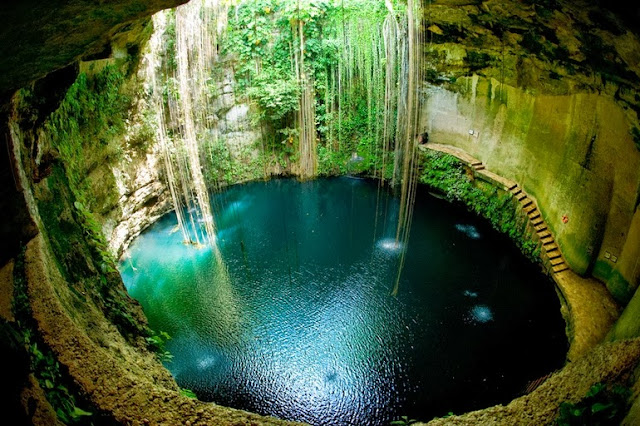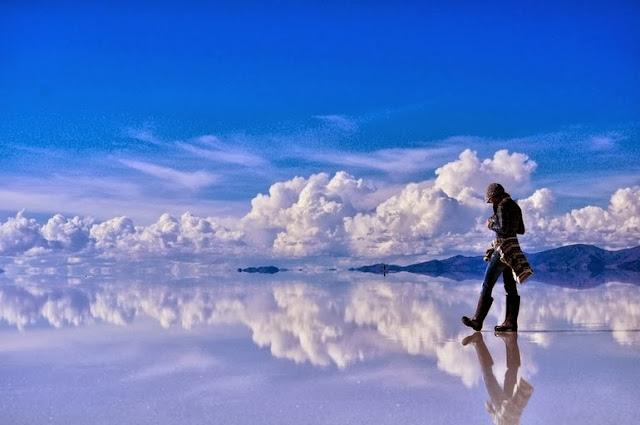Top 10 Amazing Things You Won't Believe Actually Exist In Nature
Mother Nature is beautiful and amazing because we can see many amazing stuff like these 10 things that you won't believe they actually exist. All these places are real. It is hard to believe in that, but that is true.
10. Underground natural springs in Mexico

The Yucatan Peninsula is quite rare in its construction and distinctive, with its porous limestone shelving creating large tunnels and sinkholes reaching to the depths of the Earth. These natural underground tunnels are called cenotes, and the Yucatan Peninsula is home to two thousand of them, often linked by underground rivers.
In ancient times, these cenotes were the primary water source, and were also symbolically significant as they were seen as passageways to the underworld. The ethereal feeling these other-worldly rivers produce draws thousands to explore them each year.
9. Silk Cotton Trees of Ta Prohm

If you’re up on modern movies, you’ll recognize Ta Prohm: it’s where Tomb Raider takes place. (Actually, Tomb Raider was shot all over the Angkor ruins; I have no idea how they kept Angelina Jolie from getting heatstroke. It’s bloody hot out here!)
Ta Prohm was a monastery built by King Jayavarman VII, last of the great Angkor kings, to obtain merit for his mother. When restoration of the temples began, the French Ecole Francaise d’Extreme-Orient chose Ta Prohm to be left in its “natural” state, as an example of how most of Angkor looked in the early 19th century. (They did, however, clear away the jungle and the landmines.) As a result, Ta Prohm is full of giant banyan and silk-cotton trees growing up out of the ruins–some of them over 400 years old!
Ta Prohm, with Banteay Srei (delicate pink sandstone carvings), is my favorite of the Angkor temples. The giant trees and mosses give it a pleasantly ruined/romantic atmosphere, and because it’s a little further out than Angkor Wat, it’s not quite as overrun with tourists.
8. Frozen Air Bubbles in Abraham Lake

Abraham Lake in Alberta Canada is home to a rare phenomenon that needs to be seen to believe. Trapped under it’s frozen surface, methane gas creeps its way up creating beautiful air bubbles as it freezes and melts and freezes and melts as the flammable element searches for its way out.
The methane is created when plants, and animals in the lake sink to the bottom and react with the bacteria in the water. the bacteria begins to break down the organic matter, decomposing them, slowly releasing the gas. Usually the gas floats its way to the top of the lake where it is released in the air, but when the lake freezes over, methane struggles a little more to find it’s freedom. It’s hardship shapes moving images, leaving admirers breathless.
7. Teapot Baobab

These magnificent trees, which are endemic to Madagascar are over 1000 years old. This type of Baobab in an endangered species. Many of the trees are over 80m tall and the trunks can get to 25m in circumference. The swollen trunks of the trees provide the source of water and supply it in the drought season. When in bloom, the baobab flowers only last for 24 hours. These flowers feature on the Madagascan 100 Franc banknote.
Baobabs, with their distinctive shape, are one of the most charismatic group of trees in the world. This particular specimen, located in Madagascar, is referred to as the ‘Teapot Baobab’. These trees remain leafless for most part of the year, and their thick, bloated, fire-resistant trunks store water during the dry months. One would be surprised to find that some baobab trunks are so large that people actually reside inside them!
6. Reflective salt flats in Bolivia.

A spot of reflection is always good for the soul. And judging by these pictures, there's plenty of room for that. For this is the world's largest natural mirror, created when a thin film of water gathers on a vast plain of salt deposits.So magnificent is the dream-like sight that the salt pans in the Salar de Uyuni in Bolivia have been dubbed 'heaven on earth'.Photographer Takaki Watanabe captured a series of pictures of spellbound travellers as they took in natural wonder and played around with their reflections.

Takaki journeyed to the Potosm and Oruro departments in southwest Bolivia, near the crest of the Andes, where the magnificent sight can be found at an elevation of 11,995 feet above sea level.
In one stunning picture, a woman appears to be hanging above the clouds thanks to the amazing mirror effect.
5. Volcanic Lightning in Iceland

If you are caught on a golf course during a storm and are afraid of lightning, hold up a 1-iron. Not even God can hit a 1-iron.–Lee Trevino, golfer who actually has been struck by lightning.Today’s astronomy picture of the day is absolutely gorgeous.Of course, this is the Icelandic volcano, Eyjafjallajökull, erupting and spewing up volcanic ash. But, of course, the most interesting part of this picture is the lightning, which looks like it both originates and ends in the Volcanic ash itself!
First off, I’d like to be concrete about this. The way it looks — that the lightning originates in the volcanic ash — is exactly the way it is! This isn’t some “lucky shot” by a photographer, either. Check out this picture of Eyjafjallajökull from April 17th. Is it just this volcano? Eyjafjallajökull, it turns out, is not remarkable at all for having volcanic lightning. If we look at some other major recent eruptions, we can see volcanic lightning in the ash there as well. Here’s Chile’s Chaitin volcano, from its 2008 eruption.
4. Beautiful sandstone formations in Arizona

Coyote Buttes - The Wave The Wave is located in the Coyote Buttes North area of the Arizona Strip. There are two great photographic locations in Coyote Buttes North (The Wave and The Second Wave) and numerous minor ones including Top Rock Arch, Melody Arch and the Grotto, the Hooters, The Alcove, Sand Cove, and Fatali's Boneyard. The Wave is best photographed midday so as to minimize the extensive shadows, the other areas listed above are best photographed mid-late afternoon.
The South Buttes also has many good features and is well worth visiting, as is the White Pocket and Edmaier's Secret. It can be difficult to get a permit to see the Wave. During the best months (April, May, September, October) there can be over 150 people applying for the ten daily permits. In the other months you usually have less than a 50% chance of getting one at the daily lottery. Your chances are better if you're going alone, or in December - February. If you do not win the lottery I suggest you get one for Coyote Buttes South, or go to the White Pocket which is east of Coyote Buttes South. I know of one person who was lost overnight in Coyote Buttes South, so use a GPS, mark the trailhead, and stay with your party. While a two wheel drive vehicle is adequate for the North Buttes, four wheel drive is required for the South due to deep sand. See the Information link above for more details about Coyote Buttes and the Wave..
3. Natural salt water fountain off the coast of Oregon.

Thor’s Well is part of Cape Perpetua, a typical Pacific Northwest headland – a forested area of land on the central Oregon Coast, surrounded by water on three sides. Thor’s Well is also often simply called the Spouting Horn. It is essentially a huge salt water fountain operated by the Pacific Ocean's power.This natural spectacle is at its best when it’s the most dangerous to watch – at high tide or during winter storms.
Thor’s Well can be accessed from the north side of Cook’s Chasm but there are sharp rocks everywhere and the danger of a strong surge sweeping brave visitors right up is high.For photographers, the area’s a delight, especially at sunset, yet not many know about the place or dare stay long enough to set up their tripod. We’ve found a few who did and who have come back with stunning results.
Here’s what photographer Darren White has to say about the dangers of the place:“The big waves come in like you see in the distance, they fill the hole with water and whoosh, it flies out of there... not every wave does this, it’s a matter of timing and wave size. I would guess this hole is about 20 feet deep and anyone who were to fall in would never EVER survive.”
2. Light pillars over Moscow.

When temperatures dip in these winter months and the right kind of ice crystals fill the air, you might get a chance to see a stunning optical effect known as light pillars. Light pillars occur when flat ice crystals float relatively close to the ground and cause light to bounce in vertical columns. Unlike when viewing most night sky phenomena, this one can actually improve the closer you are to a city, as airborne ice bends streetlights skyward, creating glowing, colorful stripes.
The effect can happen with natural light from the moon or sun, too, usually when either is low on the horizon. You’re more likely to see light pillars in the polar regions, but they can happen anywhere it gets cold enough. Check out these chill night lights below.Counter to the advice usually given for viewing the night sky, city lights enhance the light pillar effect, as with these glowing columns seen over Moscow, Idaho.
1. Giant clouds over Beijing.

A mushroom-like cloud was spotted over Beijing last week, closely resembling the explosion of an atomic bomb, reports China Daily.The huge cloud engulfed the city's skyline Thursday, notes the Daily Mail.Now, footage of the cloud has been released on YouTube taken from what appears to be a high-rise building in the capital.According to Wired, the mushroom-like formation was a cumulonimbus storm cloud.
To the untrained eye, it could have been the first signal of the end of the world as nuclear war broke out.But instead of anything sinister, the giant mushroom cloud spotted in the skies over the Chinese capital last week was simply a brilliant showcase of the wonder of nature.
The huge cloud, which appeared on Thursday, gradually took the shape of an explosion from an atomic bomb.But instead of being a danger to residents or marking imminent Armageddon the phenomenon was thought to be completely harmless.


0 Comments :
Post a Comment